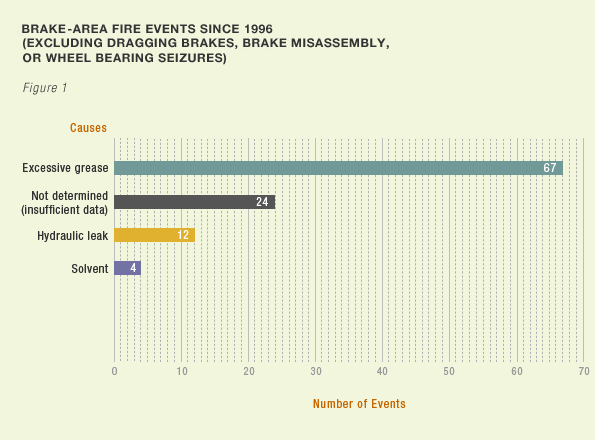
| While most wheel/brake-area fires pose no serious threat to the airplane or passengers, they can be alarming enough to cause cabin evacuations and costly delays. This article describes proper wheel/axle greasing techniques during wheel and brake maintenance and highlights the importance of not allowing flammable solvents to collect in wheel heat shields during cleaning procedures to minimize the potential for wheel/brake-area fires. |
by Brian Webber, |
Many airlines, particularly those operating carbon-braked airplanes, have experienced wheel/brake-area fires due to excessive grease buildup, incorrect grease usage, the presence of flammable cleaning solvents in wheel heat shields, or the accumulation of hydraulic fluid on the brake. In the rare instances when wheel/brake-area fires do occur, the grease, solvent, or hydraulic fluid is ignited following landing by heat generated by the application of the brakes.
Wheel/brake-area fires are occasionally reported following normal operating brake temperature condition landings (see fig. 1). The cause of the fires can usually be attributed to the ignition of excessive grease that has accumulated on the axle in the brake assembly cavity (see fig. 2, on next page). In addition, some wheel heat shields can retain residual cleaning fluids after being saturated with flammable solvents during maintenance. Wheel/brake-area fires have also been reported due to ignition of hydraulic fluid associated with leaks or hydraulic system maintenance (see fig. 3, on next page). While these fires generally do not cause major damage to the airplane or endanger passengers and crew, they can prompt evacuations that can lead to injuries, temporarily take the airplane out of service, and result in costly repairs. Yet most wheel/brake-area fires can be avoided by following some simple procedures:
- Clean all grease from the axle before reinstalling the wheel and/or brake assembly.
- Use only approved greases in small quantities at the points where the wheel and brake will contact the axle.
- Follow wheel supplier Component Maintenance Manual (CMM) cautions regarding the use of flammable cleaners on wheel heat shields, including not using dunk tanks on "sealed" heat shields.

Although these fires don't cause major damage, they can lead to delays, added maintenance costs, and evacuations.
